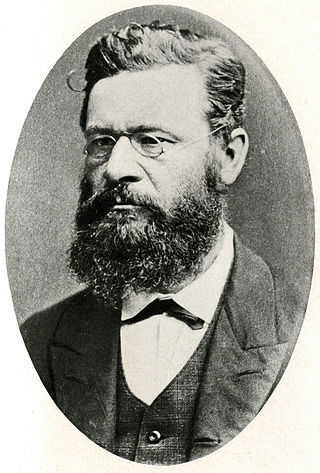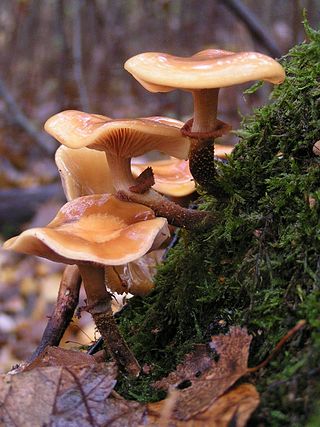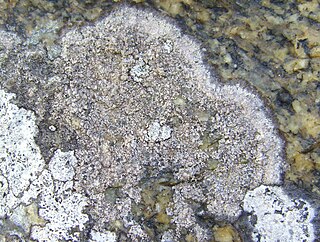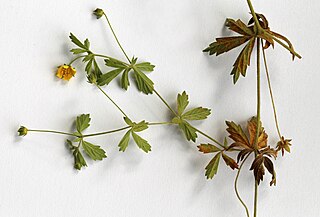
Pleurotus is a genus of gilled mushrooms which includes one of the most widely eaten mushrooms, P. ostreatus. Species of Pleurotus may be called oyster, abalone, or tree mushrooms, and are some of the most commonly cultivated edible mushrooms in the world. Pleurotus fungi have also been used in mycoremediation of pollutants, such as petroleum and polycyclic aromatic hydrocarbons.

Petter Adolf Karsten was a Finnish mycologist, the foremost expert on the fungi of Finland in his day, and known in consequence as the "father of Finnish mycology".

Kuehneromyces is a genus of agaric fungi in the family Strophariaceae. The genus was circumscribed by mycologists Rolf Singer and Alexander H. Smith in 1946.

Charles Tulasne was a French physician, mycologist and illustrator born in Langeais in the département of Indre-et-Loire.

Loreleia is a genus of brightly colored agarics in the Hymenochaetales that have an omphalinoid morphology. They inhabit mosses and or liverworts on soil in temperate regions of the Northern Hemisphere. Phylogenetically related agarics are in the genera Contumyces, Gyroflexus, Rickenella, Cantharellopsis and Blasiphalia, as well as the stipitate-stereoid genera Muscinupta and Cotylidia and the clavaroid genus, Alloclavaria. However, the large number of DNA base-pair changes causes a long-branch to form in phylogenetic analyses depicted as cladograms.
Horakiella is a genus of fungi within the Sclerodermataceae family that contains the two species H. clelandii and H. watarrkana.
Barcheria is a fungal genus in the family Agaricaceae. This is a monotypic genus, containing the single sequestrate species Barcheria willisiana, found in western Australia.
Pegleromyces is a genus of fungi in the family Tricholomataceae. It is a monotypic genus, containing the single species Pegleromyces collybioides, found in Brazil, and described as new to science by mycologist Rolf Singer in 1981.
Dennisiomyces is a genus of fungi in the family Tricholomataceae. Described by mycologist Rolf Singer in 1955, the genus contains five species found in South America.
Haasiella is a fungal genus in the family Hygrophoraceae. It is a monotypic genus that contains only the species Haasiella venustissima. Haasiella splendidissima, formerly considered to be a distinct species based on its 4-spored basidia, was found by a DNA study to be synonymous with Haasiella venustissima. Haasiella venustissima is only known from Europe and is saprotrophic on wood. Haasiella was described as a new genus in 1966 by Czech mycologists František Kotlaba and Zdeněk Pouzar. It is most closely related to the genus Hygrophorus.
Gregorella is a genus of lichenized fungi in the family Arctomiaceae. This is a monotypic genus, containing the single species Gregorella humida.

Llimonaea is a genus of fungi within the Arthoniales order. The genus has been placed into Opegraphaceae.

Jaapia is a genus in the monotypic family Jaapiaceae and order Jaapiales. The genus was first described by Italian mycologist Giacomo Bresadola in 1911, and contains two widely distributed species, J. argillacea and J. ochroleuca. The order was described in 2010.
Nematoctonus was a genus of fungi in the Pleurotaceae family, which is now considered a synonym of Hohenbuehelia. Originally the generic name —an anamorphic form of Hohenbuehelia—has a widespread distribution and contains 16 species. Under the one fungus - one name convention, the correct name for the group is Hohenbuehelia and species where the fruitbodies have not been discovered or that are older names for those described as fruitbodies have all been transferred to Hohenbuehelia.
Pochonia is a genus of fungi within the order Hypocreales and is described as anamorphic Metacordyceps; eight species are described. Previously placed in the genus Verticillium, these fungi are known to be pathogenic to nematodes and are being developed and commercialized as biological pesticides.

Frommeella (Frommeëlla) is a genus of rust fungi in the family Phragmidiaceae. The widespread genus contains two species.
Kuehneola is a genus of rust fungi in the family Phragmidiaceae. The widespread genus contains nine species.
Aquamortierella is a fungal genus in the family Mortierellaceae. The genus is monotypic, containing the single species Aquamortierella elegans, found in New Zealand and Japan.

FriedrichWilhelm Zopf was a well-known German botanist and mycologist. He dedicated to his whole life with fungal biology, particularly in classification of fungi and dye production in fungi and lichens. Besides, his textbook on fungi called “Die pilze in morphologischer, physiologischer, biologischer und systematischer beziehung ” in 1890 was also an outstanding work on the subject for many decades. The unicellular achlorophic microalgae Prototheca zopfii is named after him because of his profound suggestions and contributions to Krüger's pioneering work in Prototheca. Thus, his numerous contributions gave him a special status in mycological history.
Fischerula is a genus of two truffle-like fungi in the family Morchellaceae. First described from central Italy by Oreste Mattirolo in 1928, the genus name honors Swiss mycologist Eduard Fischer. The type species Fischerula macrospora is known only from Italy, while Fischerula subcaulis is found in coniferous and mixed forests of Oregon and Washington.










